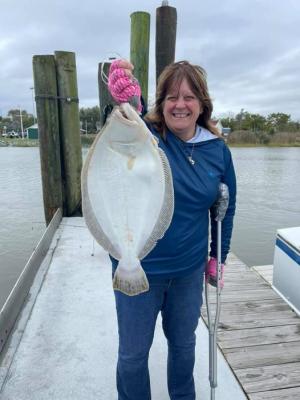The recreational fishing community is governed by the National Oceanic and Atmospheric Administration and, in Delaware and the states along the Atlantic coast, the Atlantic States Marine Fisheries Commission. In order for these two bodies to manage the fish we like to catch, they have to know, among other things, how many fish we catch. Since they can’t be there to count every fish we unload at the end of a fishing trip, as they do for commercial fishing trips, they have set up a system known as the Marine Recreational Information Program. This program replaces the Marine Recreational Fishing Statistical Survey, and to tell the truth, it doesn’t seem to be a whole lot better. Of course, that doesn’t bother the folks who continue to use these numbers to regulate our catch.
The new method does improve on the old one by mailing surveys to only those folks who have FIN numbers. The old method mailed out surveys to anyone who lived in ZIP codes near the water. The same was true for phone surveys. This, of course, eliminated everyone in Pennsylvania, Maryland and Washington, D.C.
Dockside surveys can only be held at public ramps or where the government has permission from the landowner. For 17 years, I launched my boat at Bay Shore Campground in Ocean View and never saw a survey person. I would have to assume the same would be true in all the other campgrounds and trailer parks in Sussex County.
Now that I live here and launch my boat at the Lewes boat ramp, I have been surveyed several times. Come to think of it, I have never been surveyed at Indian River Inlet or when driving off the beach after surf fishing. Then again, they certainly didn’t miss many fish by not counting what I caught at either of those locations.
So what, you may ask, does MRIP do with all the information they gather from dockside, mail and phone surveys? The process of collecting the information is known as probability-based sample surveys. A process known as statistical weighting is applied to each fishing trip they intercept and each questionnaire they receive. According to a press release from MRIP, this ensures these sampled units are representative of the full recreational fishing community.
One of the steps in weighting catch records collected by access point angler intercept surveys ensures those samples are representative of all of the fishing trips that occurred at a site during a field interviewer’s assignment rather than the angler the interviewer was able to speak with. Weighting the data from a single fishing effort survey ensures that that sample is representative of all the households in the states they conduct the survey in, not just the one household that responded.
I have no idea what the formula looks like that they enter the raw data into, but I can tell you the end product is not very accurate. As an example, in 2019, the last year I have data from, the MRIP determined that charter boats caught a total of 206 summer flounder. Heck, the Katydid and Grizzly catch more than that in a week. Then they say the shore fishermen caught 8,037 summer flounder. I sure would like to know exactly what shore in Delaware those fishermen were fishing from.
These numbers would be funny if they didn’t have so much weight when it comes to making regulations on recreational fishing. The numbers also prove what I have said for years – the people who make and use these rules have no idea what goes on outside their office. If they did, they would know that any charter boat fleet in any state that only caught 206 summer flounder in one year would no longer be in business.
I have brought this up in public hearings and in emails to MRIP without result. When pressed, they use the standard response, “We are using the best available science.”
Well, I don’t think so. In today’s world, just about everyone has a cellphone or access to a computer and the internet. Why not have all fishermen submit a catch report after every trip as to what they caught, what they released and how much time they spent fishing? This system is already in place for those who go after tilefish.
It would be easy to enforce. Every saltwater fisherman has a FIN number. If they do not submit a catch report for one year, they would not be able to get a FIN number for the next year.
Would people cheat? Of course. Some would brag they caught way more than they did, while others would say they didn’t catch anything so as not to drive up the numbers. That’s human nature. Still, the end product would be much more accurate than what we have now.























































